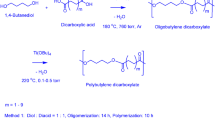Abstract
Examples of monomeric glycerol-derived hyperbranched polyesters produced in a nonpolar solvent system are reported here. The polymers were made by the Lewis acid [dibutyltin(IV) oxide]-catalyzed polycondensation of glycerol with either succinic acid [n (aliphatic chain length) = 2], glutaric acid (n = 3), or azelaic acid (n = 7) in toluene. Poly(glycerol–diacid)s were recovered in yields as low as 65% and as high as 95%. The polyesters were characterized by gas chromatography to determine the extent of reaction and by gel permeation chromatography to determine molecular weight, polydispersity index, and degree of polymerization. None of the conditions explored gave 100% conversion but products could be recovered in greater than 97.8% purity. Gelation and low conversion were observed, respectively, for 24- and 10-h polyesterifications of glutaric acid and glycerol (2:1 molar ratio) performed at 155 °C when the standard (neat) synthetic protocol was employed. Gelation was avoided and conversion improved when esterifications were performed in quasi-melt solutions with toluene. The optimal reaction conditions to produce polymers with high conversion and high molecular weight before the onset of gelation were observed for 24-h esterifications in toluene at 155 °C (2:1 molar ratio of glutaric acid/glycerol) and 135 °C (1:1 molar ratio of reactants). Expanding on the success of those findings, it was determined that gelation could be avoided for each of the three diacids studied. When all other conditions were held constant, in the absence of gelation, degree of polymerization increased with decreasing aliphatic chain length of the diacid.

Similar content being viewed by others
References
Villeneuve P, Foglia TA, Mangos TI, Nunez A (1998) Synthesis of polyfunctional glycerol esters: lipase-catalyzed esterification of glycerol with diesters. J Am Oil Chem Soc 75(11):1545–1549
Wyatt VT, Nuñez A, Foglia TA, Marmer WN (2006) Synthesis of hyperbranched poly(glycerol-diacid) oligomers. J Am Oil Chem Soc 82:1033–1039
Wyatt VT, Strahan GD, Nunez A (2010) The Lewis acid-catalyzed synthesis of hyperbranched oligo(glycerol-diacid)s in aprotic polar media. J Am Oil Chem Soc 87(11):1359–1369
Zhou H, Steinhibler D, Schlaad H, Sisson AL, Haag R (2011) Glycerol based polyether-nanogels with tunable properties via acid-catalyzed epoxide-opening in miniemulsion. React Funct Polym 71:356–361
Calderon M, Quadir MA, Sharma SK, Haag R (2010) Dendritic polyglycerols for biomedical applications. Adv Mater 22:190–218
Wurm F, Frey H (2011) Linear-dendritic block copolymers: the state of the art and exciting perspectives. Prog Polym Sci 36:1–52
Hirao A, Yoo H-S (2011) Dendrimer-like star-branched polymers: novel structurally well-defined hyperbranched polymers. Polym. J 43:2–17
Holser RA, Willett JL, Vaughn SF (2008) Thermal and physical characterization of glycerol polyesters. J Biobased Mater Bioenergy 2(1):1–3
Stumbe J-F, Bruchmann B (2004) Hyperbranched polyesters based on adipic acid and glycerol. Macromol Rapid Commun 25:921–924
Brioude MM, Guimarães DH, Fiúza RP, Prado LASA, Boaventura JS, José NM (2007) Synthesis and characterization of aliphatic polyesters from glycerol, by-product of biodiesel production, and adipic acid. Mater Res 10(4):335–339
Akat H, Balcan M (2006) Diphenylammonium triflate as an effective catalyst for polyesterification reactions. Iran Polym J 15(9):701–707
Li D, Sha K, Li Y, Wang S, Wang J (2006) Synthesis and characterization of triblock copolymer by combining enzymatic condensation polymerization and ATRP. Chin Sci Bull 51(9):1065–1068
Muscat D, van Benthem RATM (2001) Hyperbranched polyesterides–new dendritic polymers. Top Curr Chem 212:41
Bruchmann B, Schrepp W (2003) The AA*+B*B2 approach: a simple and convenient synthetic strategy towards hyperbranched polyurea-urethanes. e-Polymers 14:1–10
Bruchmann B, Koniger R, Renz H (2002) Tailor-made crosslinkers for high performance PUR coatings-hyperbranched polyisocyanates. Macromol Symp 187:271
Flory PJ (1952) Molecular size distribution in three dimensional polymers. IV. Branched polymers containing A-R-Bf-1 type units. J Am Chem Soc 74:2718–2723
Lin Q, Long TE (2003) Polymerization of A2 with B3 monomers: a facile approach to hyperbranched poly(aryl ester)s. Macromolecules 36:9809–9816
Jikei M, Kakimoto MA (2001) Hyperbranched aromatic polyamides prepared by direct polycondensation. High Perform. Polym 13:33–43
Fang J, Kita H, Okamoto K (2000) Hyperbranched polyimide for gas separation applications. 1. Synthesis and characterization. Macromolecules 33:4639
Kulshrestha AS, Gao W, Gross RA (2005) Glycerol copolyesters: control of branching and molecular weight using lipase catalyst. Macromolecules 38:3193–3204
Acknowledgments
The contributions of Dr. Gary Strahan (NMR), Aisha Abdul-Wakeel (NMR), and Kerby Jones (GC) are acknowledged for their assistance with the collection and analysis of data.
Author information
Authors and Affiliations
Corresponding author
Additional information
Mention of trade names or commercial products in this paper is solely for the purpose of providing specific information and does not imply recommendation or endorsement by the US Department of Agriculture.
About this article
Cite this article
Wyatt, V.T. Lewis Acid-Catalyzed Synthesis of Hyperbranched Polymers Based on Glycerol and Diacids in Toluene. J Am Oil Chem Soc 89, 313–319 (2012). https://doi.org/10.1007/s11746-011-1910-0
Received:
Revised:
Accepted:
Published:
Issue Date:
DOI: https://doi.org/10.1007/s11746-011-1910-0




